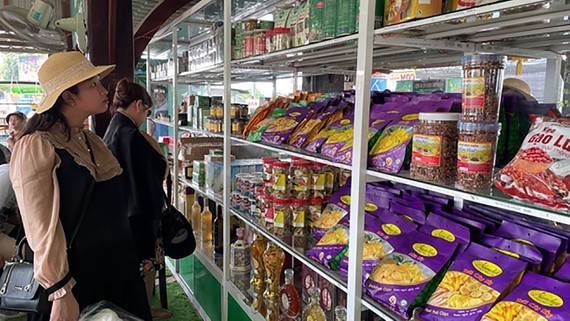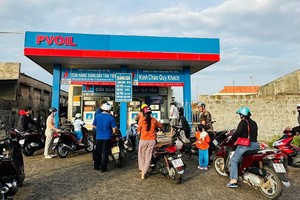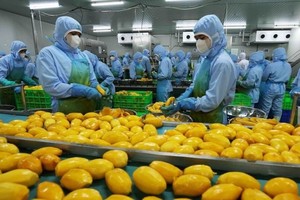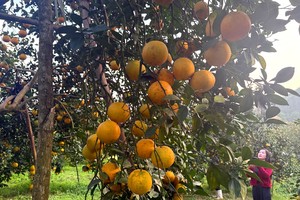
According to Mr. Nguyen Quoc Toan, Director of the Agro Processing and Market Development Authority under the Ministry of Agriculture and Rural Development (MARD), every year, the EU imports agricultural products with a total value of about US$160 billion. Vietnam has many dominant commodities, but some products have not made the most of the advantages from the EVFTA to export to the EU.
For instance, Vietnam is the world’s largest cashew nut exporter, but it has not yet benefited from exporting processed cashew to the EU market. Despite the advantage of a quota of 20,000 tons, the cane sugar industry has not had any optimistic signals yet. Honey exports to the US are the highest, followed by China and Japan, but honey exports to the EU remain modest. With the addition of the EU market, it will diversify markets and prevent breakages of the supply chain. Moreover, exporters will not be on the back foot, looking for new markets.
Under the EVFTA, deeply-processed products from cashew nuts, with a tax rate of 7-12 percent, will be reduced to zero percent. According to the Vietnam Cashew Association (Vinacas), although Vietnam is the world's largest cashew nut exporter, about 80 percent of the raw cashew output is imported. At present, African countries specializing in exporting raw cashew have also started building processing plants to produce cashew nuts for export.
In order to compete, African countries will increase the prices of raw cashew. The cashew industry of Vietnam is forecasted to be at risk of losing its position as the No.1 cashew nut exporter. At the conference to summarize the cashew industry in 2020, the Vinacas emphasized that enterprises must move to the second revolution, which is to build factories to produce processed and seasoned roasted cashew nuts to increase the global value chain.
In a recent conference of the cane sugar industry, an expert said that despite the EVFTA with a quota of 20,000 tons of sugar, no enterprises had taken advantage of this quota to export. Similarly, Mr. Le Thanh Van, Vice Chairman of the Vietnam Beekeepers Association, said that honey has been exported since 1991 and is available in the US, Japan, and the EU. Of which, honey exports to the US accounted for 80 percent. After the EU has built up strict technical barriers, tight control, and high tax rates, honey exports become extremely limited. With the EVFTA, honey receives tax exemption, but so far, Vietnam has not increased honey exports to the EU market.
With many years of experience of exporting sugar to the EU, Mr. Pham Hong Duong, Vice Chairman of Thanh Thanh Cong-Bien Hoa Joint Stock Company, said that the company exports about 30,000 tons of organic and yellow sugar annually. At the same time, products must meet strict standards, including traceability, environment, labor, and genetic modification. To export to the EU, enterprises need to develop these standards soon and head towards deep-processing because deep processing will increase the value and profit for products.
Amid difficulties and the situation that the growing area of sugarcane decreased by 40 percent, Mr. Le Ba Chieu, Deputy General Director of Lam Son Sugar Company, shared that to survive the past 20 years, besides traditional sugar products, his company has diversified its products for export, such as rock sugar, liquid sugar, and bar sugar. According to this expert, honey products must meet standards and technical barriers to export to the EU market. With the topographic advantages of Vietnam, bees can grow well and produce high-quality honey. However, in order for honey to be exported, in the short term, it is necessary to obtain international certificates and establish a local distribution chain.
Similarly, the cashew industry needs to build raw material growing areas to meet the technical requirements. Having exported processed cashew nuts to many markets, Mr. Vu Thai Son, Chairman of the Board of Directors of Long Son Joint Stock Company, shared that in the past, Vietnamese enterprises could not export processed cashew nuts to the EU market due to high import tariffs. After the EVFTA took effect, the company has contacted supermarkets for distribution.
It was extremely difficult to build a brand in foreign countries, so in the short term, Vietnamese enterprises could process cashew nuts for supermarkets to develop. Just a short time after the products were put on the shelves of supermarkets and ensured food safety, supermarkets would immediately actively negotiate with the processing companies, Mr. Vu Thai Son said. By outsourcing for supermarkets, revenues will surge because people fully trust the brands of supermarkets.
To develop the aforesaid product categories with great potentials, Mr. Nguyen Quoc Toan suggested that associations need to build cooperation plans with enterprises to connect the distribution and consumption chains from importers and supermarkets to e-commerce channels. Product categories need to develop synchronously, instead of sparsely, and change production methods to meet modern technical requirements.
Moreover, it is essential to identify objects and products to meet the technical standards of each market. Associations need to coordinate with regulator agencies to protect products and create export advantages. If the supermarket chain cannot be developed yet, the MARD can connect with commercial counselors to advertise and introduce products. In terms of management, the MARD needs to implement the codes of growing areas, geographical indications, traceability, quality, and food safety following the EU regulations.
For instance, Vietnam is the world’s largest cashew nut exporter, but it has not yet benefited from exporting processed cashew to the EU market. Despite the advantage of a quota of 20,000 tons, the cane sugar industry has not had any optimistic signals yet. Honey exports to the US are the highest, followed by China and Japan, but honey exports to the EU remain modest. With the addition of the EU market, it will diversify markets and prevent breakages of the supply chain. Moreover, exporters will not be on the back foot, looking for new markets.
Under the EVFTA, deeply-processed products from cashew nuts, with a tax rate of 7-12 percent, will be reduced to zero percent. According to the Vietnam Cashew Association (Vinacas), although Vietnam is the world's largest cashew nut exporter, about 80 percent of the raw cashew output is imported. At present, African countries specializing in exporting raw cashew have also started building processing plants to produce cashew nuts for export.
In order to compete, African countries will increase the prices of raw cashew. The cashew industry of Vietnam is forecasted to be at risk of losing its position as the No.1 cashew nut exporter. At the conference to summarize the cashew industry in 2020, the Vinacas emphasized that enterprises must move to the second revolution, which is to build factories to produce processed and seasoned roasted cashew nuts to increase the global value chain.
In a recent conference of the cane sugar industry, an expert said that despite the EVFTA with a quota of 20,000 tons of sugar, no enterprises had taken advantage of this quota to export. Similarly, Mr. Le Thanh Van, Vice Chairman of the Vietnam Beekeepers Association, said that honey has been exported since 1991 and is available in the US, Japan, and the EU. Of which, honey exports to the US accounted for 80 percent. After the EU has built up strict technical barriers, tight control, and high tax rates, honey exports become extremely limited. With the EVFTA, honey receives tax exemption, but so far, Vietnam has not increased honey exports to the EU market.
With many years of experience of exporting sugar to the EU, Mr. Pham Hong Duong, Vice Chairman of Thanh Thanh Cong-Bien Hoa Joint Stock Company, said that the company exports about 30,000 tons of organic and yellow sugar annually. At the same time, products must meet strict standards, including traceability, environment, labor, and genetic modification. To export to the EU, enterprises need to develop these standards soon and head towards deep-processing because deep processing will increase the value and profit for products.
Amid difficulties and the situation that the growing area of sugarcane decreased by 40 percent, Mr. Le Ba Chieu, Deputy General Director of Lam Son Sugar Company, shared that to survive the past 20 years, besides traditional sugar products, his company has diversified its products for export, such as rock sugar, liquid sugar, and bar sugar. According to this expert, honey products must meet standards and technical barriers to export to the EU market. With the topographic advantages of Vietnam, bees can grow well and produce high-quality honey. However, in order for honey to be exported, in the short term, it is necessary to obtain international certificates and establish a local distribution chain.
Similarly, the cashew industry needs to build raw material growing areas to meet the technical requirements. Having exported processed cashew nuts to many markets, Mr. Vu Thai Son, Chairman of the Board of Directors of Long Son Joint Stock Company, shared that in the past, Vietnamese enterprises could not export processed cashew nuts to the EU market due to high import tariffs. After the EVFTA took effect, the company has contacted supermarkets for distribution.
It was extremely difficult to build a brand in foreign countries, so in the short term, Vietnamese enterprises could process cashew nuts for supermarkets to develop. Just a short time after the products were put on the shelves of supermarkets and ensured food safety, supermarkets would immediately actively negotiate with the processing companies, Mr. Vu Thai Son said. By outsourcing for supermarkets, revenues will surge because people fully trust the brands of supermarkets.
To develop the aforesaid product categories with great potentials, Mr. Nguyen Quoc Toan suggested that associations need to build cooperation plans with enterprises to connect the distribution and consumption chains from importers and supermarkets to e-commerce channels. Product categories need to develop synchronously, instead of sparsely, and change production methods to meet modern technical requirements.
Moreover, it is essential to identify objects and products to meet the technical standards of each market. Associations need to coordinate with regulator agencies to protect products and create export advantages. If the supermarket chain cannot be developed yet, the MARD can connect with commercial counselors to advertise and introduce products. In terms of management, the MARD needs to implement the codes of growing areas, geographical indications, traceability, quality, and food safety following the EU regulations.
























